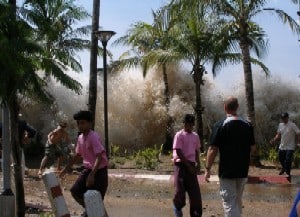
The 2004 tsunami strikes Thailand: was the wave focussed by underwater features? (Courtesy: David Rydevik)
By Hamish Johnston
One terrifying thing about the Asian Tsunami of 2004 is that some coastlines were devastated, while others had much less damage inflicted on them.
That got Bristol’s own Michael Berry thinking about whether such massive waves could be focussed by underwater features towards unfortunate places.
In an invited talk at the APS March Meeting here in Pittsburgh, Berry took us through the mathematics of how an underwater island could focus a tsumani at a region where it would unleash ten times more energy than had it not been focussed. The effect occurs because the change in depth associated with the island affects the wave much like a change in refractive index at the surface of a lens.
The intitial conditions — island size; distance to the source of the tsunami; and the size of the source — affect the degree of focussing. Berry found that in some cases the island scatters the tsumani and reduces the energy in the region directly in front of it.
Berry described this effect as “very significant and something that should be taken into account” by those investigating the possible effects of such waves.
He left us with the scary thought that a wave created by a well-placed manmade explosion at sea could in principle be focussed at unlucky coastal dwellers. Let’s hope that never happens.



